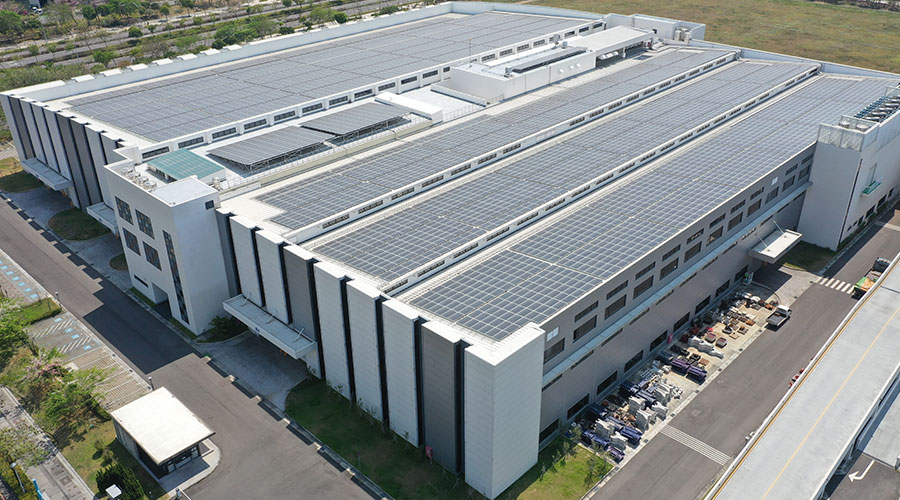3 Solar Strategies for Large Commercial Buildings

Not long ago, rooftop solar could be a complicated proposition for commercial warehouse owners and managers.
Today, that’s all changed.
Now, in many states, large commercial rooftops can transform into a tenant for solar, generating revenue for the building owner. Across the country, those rooftops can help slash energy costs, regardless of whether a building manager leases space to tenants or are owner-occupiers.
As clean energy – and solar in particular – continues to grow in popularity and affordability, there are now even more options available to building owners and managers, including behind-the-meter, front-of-the-meter, and community solar models and applications.
Community Solar: Generating Revenue and Helping Out Our Neighbors
The community solar model has spread quickly across the country for two reasons: rooftop revenue and the popularity of clean energy.
Community solar allows building owners to lease their roofs to solar companies, which then develop, own, and operate a solar energy system on their property. The landlord receives lease payments for 20 to 35 years while the solar company owns and maintains the solar system.
In a community solar model, solar arrays are installed on a central location, often the rooftop of a commercial/industrial building. The energy generated is sent to the grid with a requirement to sell the energy at a discount to individual “subscribers” in the community – often low-to-moderate-income households, as well as local businesses.
Community solar is a win-win; it provides solar benefits and cost savings to low-income communities, creates revenue-generating opportunities for property owners, and increases the use of clean, renewable energy.
Front-of-the-Meter
Front-of-the-meter (FTM) installations are solar projects that do not require the energy to be consumed onsite.
These systems are typically larger in scale and are installed on commercial or industrial rooftops or vacant land. They are usually larger because they are not limited by the energy needs of the host building. Instead, the full roof area can be used for solar, allowing it to generate the maximum amount of electricity possible.
Industrial rooftops are ideal sites for FTM and community solar projects, as they send electricity directly into the grid, creating efficiencies by generating energy closer to where it can be used by local homes or other businesses. Rooftop projects also preserve open space and avoid the need to clear trees for solar panels.
These systems are typically developed by third-party developers or utility companies and are not tied to any onsite tenant. Instead, the generated electricity is fed and sold to local or regional utilities.
Behind-the-Meter
Behind-the-meter (BTM) refers to onsite solar installations that are directly connected to a building’s electrical system, providing power primarily for the building’s consumption. This type of structure allows businesses to generate a portion or even all their electricity needs, thereby reducing reliance on the grid and cutting utility bill costs.
BTM systems can be owned and operated by the building owner. Alternatively, they can be owned by a third-party that is responsible for financing, operating, and maintaining the solar array for its entire lifespan while selling the power to the tenant(s) through a Power Purchase Agreement (PPA).
Under a PPA, a third-party developer owns, operates, and maintains the solar system on behalf of the building owner and the building owner, or its tenant(s) agree to purchase the generated electricity at a predetermined rate, typically lower than their current utility rates.
Net metering (NM) is a critical component of BTM solar installations. It allows businesses to receive credits for excess electricity generated by their solar systems, which can be used to offset future utility bills. This incentivizes solar adoption by ensuring fair compensation for surplus energy contributed to the grid.
Which One is Right for My Buildings?
No two buildings – or owners – are the same, so different models will work for different companies.
FTM systems don’t require predictable onsite energy demand, nor do they require that the building have a tenant in it at all times to consume the electricity. Whether the building is occupied or not, the building owner still receives annual lease payments.
BTM installations can be ideal for tenants or owner-occupiers looking to reduce energy costs and secure predictable long-term electricity rates while supporting environmental impact initiatives. In a BTM scenario, the onsite energy demand should be equal to or greater than the energy produced by the solar array if net metering is not an option. Since BTM systems require that the energy be used onsite – often by a tenant – these systems require much more careful planning and predictable energy demands.
Building owners should consider regulatory and financial incentives, site constraints, energy consumption patterns, and long-term sustainability goals when determining the most suitable solar structure for their needs.
No incentives last forever and our clean energy transition is accelerating every day. Now is a smart time to assess solar models that can work for your business and your community.
By Shaun Keegan, Contributing Writer
Shaun Keegan is CEO and co-founder of Solar Landscape.
The post "3 Solar Strategies for Large Commercial Buildings" appeared first on Building Operating & Management

